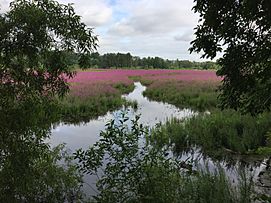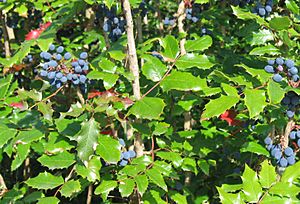Oaks Bottom Wildlife Refuge facts for kids
Quick facts for kids Oaks Bottom Wildlife Refuge |
|
|---|---|

Oaks Bottom wetland in summer
|
|
| Type | Urban park |
| Location | Portland, Oregon |
| Area | 141.22 acres (57.15 ha) |
| Created | 1959 |
| Operated by | Portland Parks & Recreation |
| Status | Open 5 a.m. to midnight; north parking lot closes at 10 p.m. |
Oaks Bottom Wildlife Refuge is a cool city park in southeast Portland, Oregon. It's about 141 acres (57 hectares) big! This park sits right next to the Willamette River and is famous for being a home to tons of different birds. In 1988, it became Portland's very first wildlife refuge. Then, in 2004, it was named the city's first park especially for birds that migrate (travel long distances).
Contents
Exploring Oaks Bottom Wildlife Refuge
This long park has many different natural areas. You can find a shallow lake that appears in certain seasons, plus wet, marshy lands called wetlands. There are also open grassy spots and forests with maple and oak trees.
Paths and Trails to Discover
A path for hiking and biking, called the Springwater Corridor, goes through the park. It runs right next to the Willamette River. You'll also see Oregon Pacific Railway train tracks on a raised area next to the path.
Nearby Parks and Landmarks
Just south of the refuge are Sellwood Park and Sellwood Riverfront Park. Oaks Amusement Park is to the west, close to the river. To the east, on top of a steep hill (a bluff) overlooking the lake, are mostly houses. One building there is a mausoleum (a building for tombs) and a crematorium. It has a huge painting of a great blue heron on it, looking over the wetlands.
Hiking Around the Lake
A one-mile (1.6 km) hiking trail wraps around the east side of the lake, below the bluff. Another small trail connects this east trail to Sellwood Park. In the northern part of the refuge, you'll find more forests, bushes, and open fields. A trail crosses this northern section, linking the Springwater Corridor to a parking lot at the top of the bluff.
Islands and Bird Homes
West of the northern part of the refuge are two islands, East and Hardtack. These islands are part of the Ross Island group in the Willamette River. Ross Island is a special place where herons gather to nest, called a rookery.
History of Oaks Bottom
Before Oaks Bottom became a park, the raised train tracks had mostly separated the wetlands from the river. The southern part of the wetlands was once used as a city landfill (a place for trash). The city bought this land in 1969 to stop it from being used for factories. Later, the city filled the northern part of the park with leftover materials from building Interstate 405 in downtown Portland.
Saving the Wetlands
In the early 1970s, there was a plan to fill in the rest of the wetlands. The idea was to build museums, maybe a motocross course, and even a gondola lift to bring visitors from the bluff down to the park. But groups like the Audubon Society of Portland, the Sellwood-Moreland Improvement League, and The Nature Conservancy spoke up. They convinced the city to stop filling the wetlands.
Becoming a Wildlife Refuge
After many years of discussion, officials finally named Oaks Bottom as Portland's first urban wildlife refuge in 1988. Since then, a volunteer group called Friends of Oaks Bottom has helped the city's parks department. They work on keeping the trails nice, restoring the natural habitats, and sharing information with visitors.
A Park for Migratory Birds
In 2004, Oaks Bottom was named the city's first migratory bird park. Portland was one of five cities to get a $50,000 grant from the US Fish and Wildlife Service to create such parks. Thousands of birds that travel long distances visit the refuge each year during their flights north and south.
Plants and Animals of Oaks Bottom
As of 2010, more than 185 different kinds of birds have been seen at Oaks Bottom. These include herons, egrets, hawks, osprey, shorebirds, gulls, terns, hummingbirds, woodpeckers, grebes, falcons, vultures, waterfowl, and many others!
Diverse Plant Life
The plants in the refuge are different depending on where you are. You can find Oregon white oak, Pacific madrone, ash, and black locust trees. There are also ferns, Oregon-grape, Scotch broom, and poison oak. Other plants include rushes, sedges, and many more.
Fighting Invasive Species
Some plants that are not native to the area, called invasive species, are slowly being removed. These include reed canary grass, purple loosestrife, and Himalayan blackberry. They are removed by hand or by controlled burning.
Water Flow and Beavers
The parks department manages the water flow in and out of the wetlands. They add or remove boards at a small dam near the railroad tracks. This helps to create conditions similar to when the wetlands were naturally connected to the river. Some water in the wetlands comes from natural springs, and some comes from the river when it's high in the winter.
Sometimes, Beavers try to change the plan by building their own dams on the small stream that connects the lake and the river. To fix this, the parks department has put a special pipe with holes through the beaver dams. This allows the water to flow as planned.


